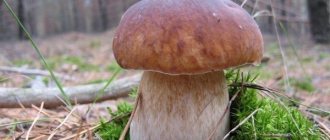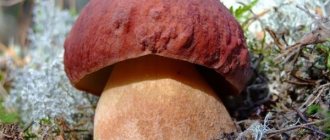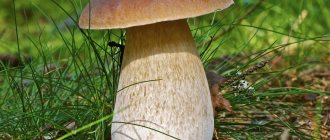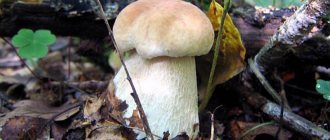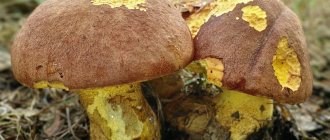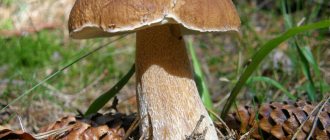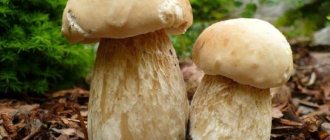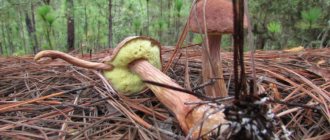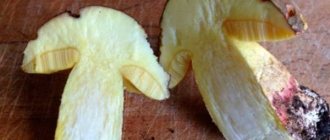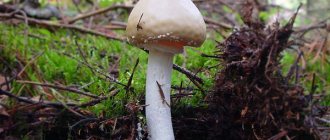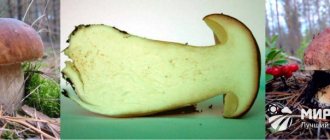What do bronze boletes look like?
The bronze bolet has a fairly large cap, on average about 17 cm in diameter, the thickness of the cap is up to 4 cm. At a young age, the shape of the cap is convex and almost spherical, but over time it straightens and becomes prostrate. In young fruiting bodies, the surface of the cap is smooth; with age, uneven depressions appear on it, located mainly closer to the edges.
The bronze bolet has a dark chestnut, almost black coloring of the cap when young. At the same time, there are areas with a whitish coating on it; this feature is characteristic of the bronze boletus. As it matures, the cap lightens a little and becomes chestnut or brown with a copper tint. You can also recognize a bronze bolet by the fact that its cap is always dry. It does not become slimy even with high humidity.
The underside of the cap is covered with tubes with small angular pores. In young fruiting bodies the tubular layer is white or grayish-white; with age it becomes pale yellow or creamy, and in old age it becomes olive-yellow. If you press on the tubular layer, a dark spot will quickly appear at the point of contact.
The bolet can rise above the ground by 12 cm, the thickness of the leg is 4 cm. The shape of the leg is thick, with a seal at the bottom, club-shaped or tuber-like, and with age it acquires a cylindrical shape. The surface of the leg is wrinkled and hard to the touch. Young mushrooms have almost white legs, but with age the color changes to pinkish-beige or olive-beige, with a brown lower part.
If you cut the bolet along the cap, the flesh will be dense and uniformly wine-red in color if the fruiting body is young. In old fruiting bodies the flesh is almost white, yellowish closer to the tubes and softer. When broken, the flesh quickly darkens and has a neutral smell and taste.
Option No. 2
Another option is to take a fairly mature bronze boletus and soak it in a bucket of water. Some people recommend adding a packet of yeast to the water. After a day, knead the cap with your hands. Strain the resulting mixture. Throw away the grounds, and pour the liquid, which contains a lot of fungal spores, under a tree - a potential symbiont.
If there are several such trees, you can water them all if you wish; the spores in one cap are enough for 4,200 liter barrels of seed solution. If the weather is dry, water the planting areas once a week.
Sowing bronze boletuses in open ground does not provide a 100% guarantee of results, although if the technology is followed, the probability of getting a mushroom plantation is quite high. However, there is a way to breed boletus mushrooms indoors. This is a much more labor- and capital-intensive task, but success is more likely in this case.
To grow bronze Bolets, you will need two clean, dry rooms, in which it is necessary to carry out anti-mold treatment, then thoroughly ventilate and dry.
It is necessary to think over and install ventilation, watering, heating systems, as well as fluorescent lamps.
To germinate spores, you will need the first room. It should be darkened, the humidity in it should be at least 95%, and the temperature should be 23-25 oC.
To ripen the fruiting bodies, you need ventilation for a good supply of oxygen, a lower (12-18 oC) temperature and daylight for at least 3-4 hours a day (lamp are also suitable).
Excess moisture here will do harm; one or more, depending on the size of the room, containers with water will be enough.
You should choose planting material based on recommendations and reviews. Check the mycelium before paying: healthy mycelium is orange-yellowish. It should not have a trace of ammonia smell; such mycelium was overheated during storage and is now non-viable.
The substrate for sowing is made from any plant waste and forest litter is added to it. There should be no mold or rot anywhere! All this must be mixed, crushed and steamed for 3 hours with water, the temperature of which is maintained at 70-80 oC.
Then the excess water is drained and the mixture is allowed to cool to room temperature. Take a handful of substrate. It should compress easily without releasing excess water. If there is any, then you need to let it drain for up to several days.
Inoculate the substrate with mycelium in a sterile, sealed (ventilation turned off, doors and windows closed) room, wearing sterile gloves, strictly following the instructions on the package.
The mycelium is crushed directly in the package and opened only later. Mycelium is added to the substrate in a ratio of 3-5:100 if it is produced in Russia, and 1.5-2.5:100 if it is produced in Europe. Everything is mixed and packaged in polypropylene bags or planting boxes.
Cross-shaped incisions about 1 cm long are made in the bags using a sterile scalpel blade. All that remains is to place the bags on the shelves in the germination room so that the distance between them is at least 5 cm.
After a month, the bags are transferred to the germination room. The usual lifespan of such planting is up to six months. This allows you to timely introduce fresh mycelium for germination.
Where do bronze boletus grow?
It is rare to see bronze boletus in Russia. It mainly grows in southern regions with warm climates on moist humus soils. It grows mainly in mixed forests with the presence of beech or oak, and is also found under pine trees. You can see boletus either alone or in small groups of 2-3 specimens.
Advice! Bronze boletus begins to bear fruit in mid-summer, but the largest number of fruiting bodies appears in August and September. It is at this time that bronze boletus should be collected, and for a trip to the forest it is better to choose damp weather; with high humidity, the mushroom fruiting bodies grow most actively.
Growing at home
Option #1
Growing different types of boletus mushrooms on a personal plot proceeds approximately the same way. The difference is which type prefers to form mycorrhiza (in other words, live in symbiosis) with which tree. Without related mature trees, not a single boletus species will bear fruit well.
That is why industrial cultivation of mushrooms of this kind is not profitable, but amateur gardeners sometimes manage to get good results.
True, not right away: for the formation of mycorrhiza, you need not only a “related” tree, but also time. The formation of a stable tree-mushroom connection takes 2-3 years.
The optimal period for sowing mushrooms in open ground depends on the region. There should be at least a month and a half between sowing and frost, but sowing mushrooms in extreme heat is not the best option. For bronze porcini mushrooms, planting is recommended from May to October.
It is fortunate if the dacha is located next to a forest where bronze bolets grow. Then find a mushroom in the forest growing under a tree that is on the site.
Cut a 20x20 cm square of turf around it. This will be the mycelium. Under your tree, remove the top layer of soil and place compost or a mixture of peat and soil in the area. Put mycelium there. Place the soil that was removed on top.
Using the same method, instead of wild mycelium, you can sow dry mycelium, which you can buy, mix with sand in a ratio of 20 g per 1 liter and lay out this mixture instead of forest turf, then carefully water it by drip.
Carefully read the instructions on the mycelium packaging, it will indicate which trees the mushrooms of this particular manufacturer can symbiosis with.
False doubles
Bronze bolete does not have toxic inedible counterparts. But this mushroom can be confused with some edible varieties.
Polish mushroom
Bolet has a certain similarity with the edible Polish mushroom - adult fruiting bodies also have a cylindrical dense stalk, topped with a hemispherical or cushion-shaped cap of a red-brown, chocolate or chestnut hue.
The varieties can be distinguished from each other mainly by the absence of a mesh on the stem of the Polish mushroom. In addition, if you cut the fruiting body, its white flesh will very quickly turn blue from exposure to air.
Semi-bronze bolet
The semi-bronze boletus has a strong resemblance to the bronze boletus. The varieties are very similar to each other in structure and size, and have caps of the same shape. The main difference is the shade of color - the semi-bronze boletus is lighter, its cap is usually gray-brown, with yellowish spots.
Important! Since the semi-bronze bolet is edible, even if it is mistaken, it will not cause harm to health. But the taste of this mushroom is not as delicious as that of the bronze boletus.
Pine white mushroom
The edible white pine mushroom is often confused with other representatives of boletus mushrooms, including the bronze boletus. But unlike bronze boletus, white pine grows only in coniferous forests and is not found in deciduous forests. In addition, its cap is wine-red or brown-red, and in terms of the size of its cap and legs it is larger than the bronze bolet.
Bile mushroom
Very often, boletus mushrooms, including the bronze one, are confused in Russia with the gall fungus. Gorchak has a very similar structure and can be almost indistinguishable from bronze bolet. But you can recognize it by the unique structure of the stalk - in bitterling it is covered with pronounced vascular veins.
Although the gall fungus is not poisonous, it is not suitable for human consumption. The bitter taste of the mushroom can ruin any dish, and the bitterness cannot be eliminated by soaking or boiling.
Attention! Another characteristic feature of inedible bitterling is the pulp, untouched by insects, even in old fruiting bodies. Gorchak has a very pungent taste, so worms and flies do not touch it.
Interesting Facts
Boletus is dark chestnut.
- Bronze boletus is a fairly rare species. For this reason, this mushroom is included in the Red Books of a number of countries (some Scandinavian, such as Denmark and Norway). It is also considered an endangered species in Montenegro.
- Finding a bronze boletus due to its rarity and excellent taste characteristics is a real success. It is practically never found in the forests of central Russia, preferring warmer places.
Even with such a high rating of qualities, bronze sick should not be consumed by small children and patients with gastritis, since mushrooms are quite difficult to digest and therefore can cause gastrointestinal disorders.
Collection rules
You should look for boletus in the forests closer to autumn, in mid-August or even early September. At this time it is found most often, although it still remains rare and is found only in the southern regions.
To collect bolet, you need to choose only clean forests located away from roads. Near highways and industrial facilities, mushrooms absorb too many toxic compounds and it becomes unsafe to eat them.
When collecting boleta, you need to use a sharply sharpened knife or twist the fruiting body out of the ground and try not to damage the mycelium. If you simply pull a boletus out of the soil, it is unlikely to grow back in the same place later.
Use
Edible boleth is suitable for consumption in any form. It cannot be eaten raw, but after boiling it can be added to other dishes or fried and pickled. Boletus can also be dried, which will preserve its taste and beneficial properties for many months.
Before frying or pickling, the bolet is subjected to a short processing. The pulp must be cleaned of all adhering debris, rinsed with cool water and the lower part of the stem cut off. After this, the bolet is soaked in cold water for 15 minutes, and then boiled with salt for 20 minutes if the mushrooms are going to be fried, and 40 minutes for pickling or eating boiled.
